CMB Polarisation: Cosmic Microwave Background Polarisation mission
Mission Justification
The highly successful ESA Planck space mission has demonstrated the capability of precision Cosmic Microwave Background (CMB) observations to constrain models of fundamental physics in the primordial Universe. Planck was primarily designed as the near-ultimate space mission for measuring the angular power spectrum of CMB temperature anisotropies, and has also made the most constraining measurements so far of E-mode polarisation. However, much remains to be learned from CMB polarisation, especially with regard to the much fainter B-modes, which are the signature of gravitational waves generated during inflation.
Science Objectives
The mission is primarily designed for the detection and characterization of primordial B-modes generated by inflation, targeting a detection and confirmation of the inflationary origin of the observed B-modes down to a tensor-to-scalar ratio level of r = 10-3. The primordial B-mode signal appears primarily at angular scales larger than about 20 degrees on the celestial sphere (the reionization peak at l ≤ 10), and at angular scales of a few degrees (recombination peak at l ~ 100). Observing the reionization peak with adequate statistics requires covering as much of the sky as possible (at a minimum more than 75%).
Lensing of E-modes by intervening matter introduces a B-mode signal which for r ~ 10-3 is the dominant signal at l > 10. Polarised galactic emission dominates the entire sky and introduces an additional B-mode signal which is most significant at the largest angular scales. To measure the primordial B-mode signals, strategies have to be put in place to estimate and remove the contribution of both foreground and lensing-induced B-mode signals. These strategies require a wider frequency coverage and higher angular resolution than required by the CMB signal alone.
Mission Requirements
The main mission requirements for this study are:
- A telescope with 1.2m effective aperture, operating below 60K.
- Frequency coverage of ~50-500 GHz spread over ~15 bands, and a sensitivity to the CMB signal of ~2 µK arcmin. Reaching this typically implies a ~50 cm-diameter Focal Plane Array with >2000 detectors operating at 100mK.
- Orbit: Large amplitude Halo orbit around L2 (like Herschel).
- Launch Vehicle: Japanese H-II/H-III launcher or European Ariane 6.2.
-
Full sky coverage with scanning law consisting of three combined rotations:
- Spin @ 2 RPM around axis at β = 45 deg with respect to optical axis
- 4-day precession of spin axis with α = 50 deg with respect to Sun line
- Daily Sun-Spacecraft line rotation to follow the solar orbit
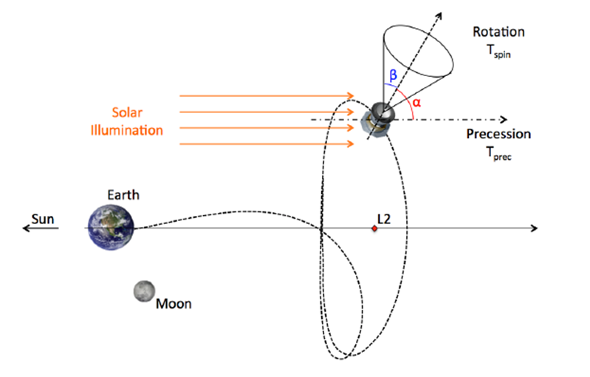 |
| CMB Polarisation mission orbit and scan strategy. Image Courtesy: Core+ consortium |
Study results: baseline
|
CMB Polarisation System Characteristics |
||
|
|
||
|
Total mass (with margin) |
Dry mass: 1840 kg |
|
|
Total: 2185 kg |
||
|
Service Module – System Characteristics |
||
|
|
||
|
Power |
Solar Array |
|
|
Communications |
Ka-Band with steerable antenna |
|
|
Payload Module – System Characteristics |
||
|
|
||
|
Payload module mass (with margin) |
Total: 920 kg (no propellant in payload module) |
|
|
Telescope |
1.2m aperture Gregorian Silicon Carbide (SiC) telescope |
|
|
Active Cooling |
7 x 20K-class 2-stage Stirling Coolers |
|
|
2 x 4K-class Joule-Thomson Coolers |
||
|
2 x 1K-class Joule-Thomson Cooler |
||
|
Passive Cooling |
3 thermal shields: Aluminium Sandwich Panel |
|
|
Sunshield: Sandwich Panel |
||
|
Bipod structure: |
|
|
Further details can be found in the CDF summary slides (CMB Polarisation mission - summary presentation) and the CDF Final Presentation slides (CMB Polarisation mission - full presentation).

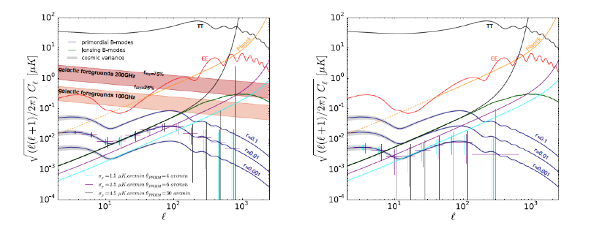
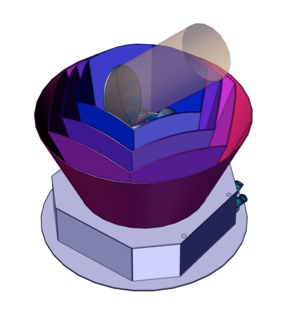
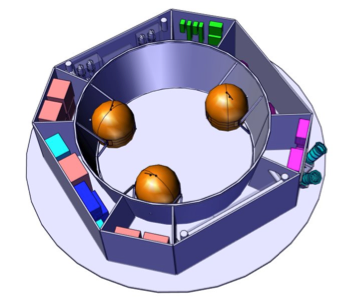
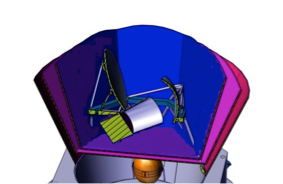
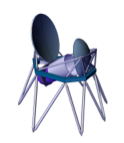 GFRP struts
GFRP struts
